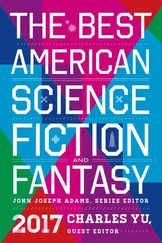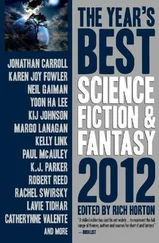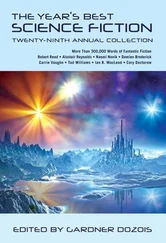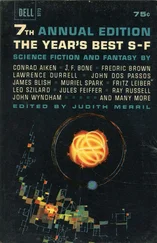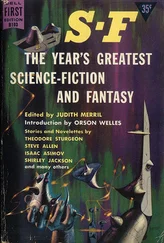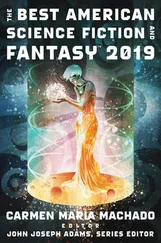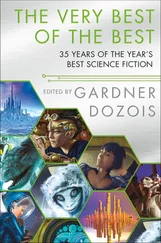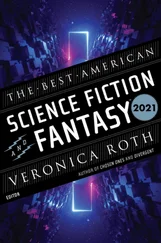Judith Merril - The Year's Greatest Science Fiction & Fantasy 6
Здесь есть возможность читать онлайн «Judith Merril - The Year's Greatest Science Fiction & Fantasy 6» весь текст электронной книги совершенно бесплатно (целиком полную версию без сокращений). В некоторых случаях можно слушать аудио, скачать через торрент в формате fb2 и присутствует краткое содержание. Год выпуска: 1962, Издательство: Dell, Жанр: Фантастика и фэнтези, на английском языке. Описание произведения, (предисловие) а так же отзывы посетителей доступны на портале библиотеки ЛибКат.
- Название:The Year's Greatest Science Fiction & Fantasy 6
- Автор:
- Издательство:Dell
- Жанр:
- Год:1962
- ISBN:нет данных
- Рейтинг книги:3 / 5. Голосов: 1
-
Избранное:Добавить в избранное
- Отзывы:
-
Ваша оценка:
- 60
- 1
- 2
- 3
- 4
- 5
The Year's Greatest Science Fiction & Fantasy 6: краткое содержание, описание и аннотация
Предлагаем к чтению аннотацию, описание, краткое содержание или предисловие (зависит от того, что написал сам автор книги «The Year's Greatest Science Fiction & Fantasy 6»). Если вы не нашли необходимую информацию о книге — напишите в комментариях, мы постараемся отыскать её.
The Year's Greatest Science Fiction & Fantasy 6 — читать онлайн бесплатно полную книгу (весь текст) целиком
Ниже представлен текст книги, разбитый по страницам. Система сохранения места последней прочитанной страницы, позволяет с удобством читать онлайн бесплатно книгу «The Year's Greatest Science Fiction & Fantasy 6», без необходимости каждый раз заново искать на чём Вы остановились. Поставьте закладку, и сможете в любой момент перейти на страницу, на которой закончили чтение.
Интервал:
Закладка:
Our first astronauts then must be the wisest and most temperate men, slow to revulsion, quick to sympathy, capable even of having their concepts of male-female sexuality shaken. On the planets of Tau Ceti sexes may be combined in one body or, worse from our lusty view, may be lacking altogether because more efficient if less invigorating ways have been found by nature to keep a race going.
Thus far we have dealt with planets enjoying climates as bright and fine as ours. But even on such worlds, spendthrift creation is almost certain never to repeat an accident in the same way. Man, ape on the way to being angel, is but one of a trillion happenstances, neither better nor worse than trillions of others thrown up for grabs in island universes we will never see.
So while we may find cities on other worlds, they will not look like cities, the houses not quite houses, and the furniture and art all a little wrong to our jaundiced eyes. We will watch games that seem hardly games, hear songs just barely songs, all on worlds exactly like ours in natural environment.
But what of planets swinging about redder or whiter suns than ours, covered with lethal atmospheres where we will move like deep-sea divers in our space suits?
Earth life is based on carbon and oxygen. Does it have to be, on other worlds? No. Here are some other possibilities:
A world where the air is a hydrogen-peroxide vapor. This vapor, breathed in by animals, could be broken down into oxygen and water for use by their bodies.
A world where fluorine might be inhaled as a gas by living creatures. The skin of flourine-breathers, however, would be leathery and unpleasant and the world itself so nightmarish that our space men probably would not stay more than an hour.
But in the creation of life the atmosphere of planets is less important than the kind of warm-broth seas that covered them in their formative years. We men are built largely of carbon which, billions of years ago, formed the basis of increasingly complicated chemical compounds that changed and changed again until at last they came alive.
We carbon creatures are prejudiced in our own favor because, in all truth, carbon life can survive environmental dangers that other noncarbon forms could not possibly stand. So versatile is it, in fact, that if ever carbon life and silicon life came into existence simultaneously, carbon life would wipe out the silicon life. So versatile is carbon that out scientists long ago divided their studies into organic (carbon) chemistry and inorganic chemistry. Carbon, a virtuoso performer, can do more tricks than the whole theater of all the other known chemical elements. Silicon is the only other element that approaches it. Can we then expect to find silicon life in the universe?
There is one serious flaw in imagining silicon creatures. We breathe out carbon dioxide, which is a gas. “Silicon creatures,” says Dr. Tombaugh, “would breath out silicon dioxide, which is quartz.”
It is hard to imagine an animal exhaling crystals of quartz as it moves through its world. Silicon life would need to breathe something like flourine. This would cause it to exhale silicon-tetra-fluoride, after using the liberated energy. This, too, would result in a creature far removed, if even faintly resembling, ourselves.
What we have guessed so far is unpromising, unsettling, sometimes terrifying. How nice it would be to step off our rocket on some far world and find just home folks like us.
It could happen.
Thomas Gold of Cornell’s space research group believes Earth may have been visited by cosmic neighbors a billion years ago. Finding the climate not to their taste, they dumped their picnic trash and left. From this discarded lot, bacterial life in its own good billion-year time evolved up to present-day man. We, too, some year, may seed other worlds with Coke bottles, paper napkins and orange peels from which our germs, invisibly stamped with our images, might rise up and walk on legs a billion years hence. So the creatures of the universe, through an intergalactic untidiness, might summon forth twins a thousand million sunrises apart.
Improbable. But improbable, too, is the thought that spores, drifting down the star winds, may have carried life from other nebulae to ours. Or the thought that perhaps huge meteoroids, shot across the abyss, carried out the work. Yet there is evidence that this may have happened. Dr. Melvin Calvin of the University of California at Berkeley has discovered recently, in examining meteor bodies, molecules resembling the basic stuff of genetic material here on Earth. In these blazing gifts from space he found prebiological forms that have not been on Earth for millions of years. These chemical combinations were the very ones that had to occur before life could stir.
In the scientific laboratories experts are experimenting with the creation of life in a test tube. In an artificial recreation of our raw and nightmarish environment when lightnings prowled our world like unchained beasts, Scientist Stanley L. Miller subjected a mixture of methane, or marsh gas, hydrogen, ammonia and water to electrical discharge. The result was the production of amino acids: Biochemist Sidney W. Fox, of Florida State University, has carried the process one significant step further: from the amino acids he has produced substances resembling proteins which then form tiny spheres which look like—and in some ways act like—bacteria.
Life in a test tube: a mystery.
Life on Earth: a mystery.
Life on other worlds: a mystery.
The mysteries move closer together through the immense shuttling of our thoughts, our laboratory devices, our far-traveling rockets.
The dust which once flew in the voids, the stuff of the sun, the mineral trash of Earth, has reared itself up in our time to become man—to speak in tongues, to put forth hands and, with one of its billion-year-developed senses, to see those beckoning stars. That dust which came down through cycles of destruction and rebirth now desires to seek other dusts, to know what further shapes strange suns and gravities may have given them.
In our time this search will eventually change our laws, our religions, our philosophies, our arts, our recreations, as well as our sciences. Space, the mirror, waits for life to come look for itself there.
ED LEAR WASN’T SO CRAZY!
by Hilbert Schenck, Jr.
The owl and the pussycat went into space
In a modified Jupiter C.
They took some lox, and standard clocks
And an ape with a Ph.D.
The owl took a sight on the stars above,
And sang to the guide beam’s sound,
“Oh lovely pussy, oh pussy my love,
We should never have left the ground,
The ground,
The ground!
We should never have left the ground.”
Pussy said to the owl, “Our atmosphere’s foul,
And your singing’s upsetting our course.
But let us be wedded and compute where we’re headed,
We will send our decision in Morse.”
So they rocketed gay, the elliptical way,
To the land where the fungus grows.
And there, as he should, a Martian stood,
On a ring instead of his toes,
His toes,
His toes,
On a ring instead of his toes.
“Will you loan us your ring, if the owl doesn’t sing?”
Telepathed back the Martian, “I will.”
So they dragged it away, and were married next day,
By some sort of a thing with a gill.
They dined on yams and boneless hams,
While the Martians espied them in mirth.
And hand in hand on the ruddy sand,
Each thumbed, his nose at the earth,
The earth,
The earth,
Each thumbed his nose at the earth.
INSTRUCTOR
by Thelwell
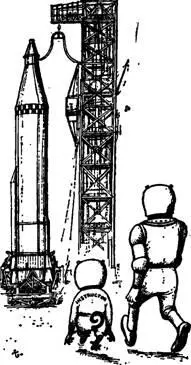
Интервал:
Закладка:
Похожие книги на «The Year's Greatest Science Fiction & Fantasy 6»
Представляем Вашему вниманию похожие книги на «The Year's Greatest Science Fiction & Fantasy 6» списком для выбора. Мы отобрали схожую по названию и смыслу литературу в надежде предоставить читателям больше вариантов отыскать новые, интересные, ещё непрочитанные произведения.
Обсуждение, отзывы о книге «The Year's Greatest Science Fiction & Fantasy 6» и просто собственные мнения читателей. Оставьте ваши комментарии, напишите, что Вы думаете о произведении, его смысле или главных героях. Укажите что конкретно понравилось, а что нет, и почему Вы так считаете.

